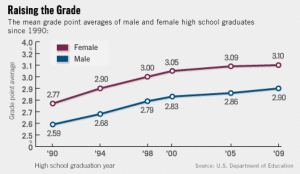Phoebe Barr ’19: “Grade Inflation,” the idea that students today earn higher grades than students of previous decades, has been causing increasing worry at many school across the nation. According to a study done by the National Center for Education Statistics, the average high school GPA across the country rose from 2.77 in 1990 to 3.10 in 2009 for girls and from 2.59 to 2.90 for boys in the same period. These raw numbers appear to provide concrete evidence of grade inflation, but opinions on the topic are varied among students and faculty throughout EA.

Molly Konopka, Middle and Upper School Latin Teacher, says, “It’s not right. Everyone is not an A student, and yet the majority of students are getting A’s. In 1984, the 29th kid in the class had a C+ average at Episcopal. But now I’m sure that the 29th kid in any Episcopal class in the last 10 years did not have a C+ average.”
Thomas Kent, also a Middle and Upper School Latin teacher, wrote an essay on the subject in 2010, explaining the idea that “A’s are being handed out so readily that they are becoming all but meaningless and B’s’ are in fact below average. C’s’ are as good as failing… One could comment on any grade below a C’, but since they are nearly never given out, it’s not worth mentioning.” Students point out the increased pressure this puts on them to achieve. Alyssa Sheffy ‘19 says, “At EA, everyone feels that they have to get straight A+’s in order to get into a good college.”
Teachers also worry about what will happen when students used to getting straight A’s enter a world in which perfection is impossible. Dan Clay, Head of the Theater Department, explains, “Adults are not really preparing kids for what’s going to happen in the real world. The world is very competitive, and you have to be the best at what you do.” He continues, “You have to practice and be able to fail and have a realistic goal to reach and surpass, so that you have a measure of how difficult the average task us in the world. I think we’re setting kids up for failure.”
There are many possible causes for this speculated grade inflation. One such cause is the failure to acknowledge and interpret the true meaning of a grade’s value. The same essay written by Kent poses the question: “What exactly are the final grades we give to a student supposed to represent? a) The child’s relative standing in the class when compared to his classmates? b) The degree to which the child has mastered the skills and concepts presented in the course?”
Kent continues to explain that in one system of grading, scores were placed on a “bell curve,” with the most common or “average” scores being given a C grade, the lowest an F grade, and the highest an A grade. Yet this system is inherently relative, and Kent’s essay points out, “We run the risk of simply reducing education to a competitive exercise where learning is secondary to ‘winning’ … and will not necessarily reflect what a student has learned. Furthermore, it encourages students to view their classmates not as colleagues but as opponents, and therefore at odds with the practice of positive collaborative work among our students.” The idea of “curving” a test grade, which many people point to as a prime example of grade inflation, is based on this “bell curve” system. A test’s curve is typically determined by how well everyone else in the class did. If everyone did poorly, everyone will get a large boost in grade.
The most commonly understood system of grading today is based on an objective rubric, in which a student’s mastery of the material is the sole basis for a grade. If grades are inflated within this system, Kent asserts, “The real and justifiable concern is when a student who can’t read, can’t write, and can’t add, subtract, multiply or divide, nevertheless receives grades that suggest she/he can.” There are potential causes for this kind of grade inflation as well.
Damon Kuzemka, Upper School History teacher says, “teachers don’t want to hinder students’ opportunities. At least here at Episcopal, the impression is other schools have inflated grades, therefore their students are getting opportunities ahead of ours, so there’s pressure on the teachers here to respond in kind.”
The concern for grade inflation also stems from parental pressure. Konopka explains, “Part of it is there’s such consequences if kids get lower than a B. It’s a double-edged sword. Lots of parents don’t want grade inflation, but they also don’t want their kids to get anything but As. So then there’s pressure on schools to make sure everyone’s getting high grades, because parents are paying the tuition for their children to get high grades.”
Others however, argue that grade inflation is extremely exaggerated and may not exist at all. Cheryl McLauchlan, Form Dean and math teacher, expresses her view, saying, “The kids I teach all across the board work harder and are smarter than the kids I taught 47 years ago.” She continues, “If I’m teaching an honors class and they’re all working hard and they’re not getting A’s or B’s, they’re not in the right place.”
An article published on the standardized test practice website Albert.io reveals the national GPA averages also factor in the increased number of honors and AP classes students are taking throughout the country. And, as Mehringer explains, “Teaching has come a long way from where it was when I first started. We spend more time preparing for what we do with our students than people did when I first started. The textbooks weren’t as organized then, and they didn’t have the idea of different learning styles. We’ve come a very long way with being able to evaluate, and it’s much better than it used to be.”
Jacob Viscusi ‘19 agrees, saying “A percentage is a percentage. So if the average grade in math class used to be a C but now it’s like a B or an A… maybe kids are just getting smarter.”
